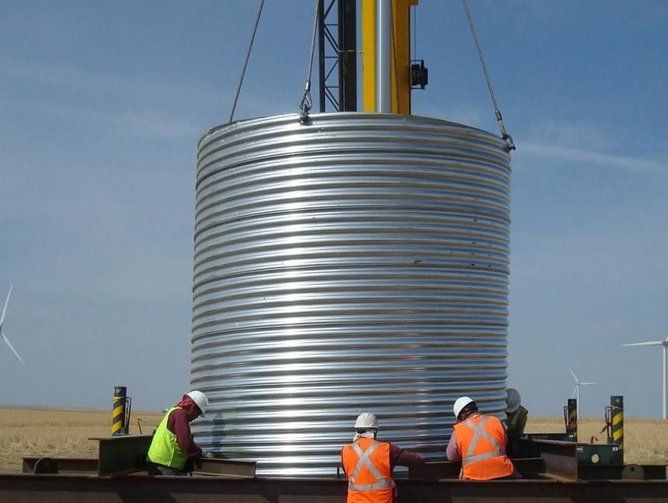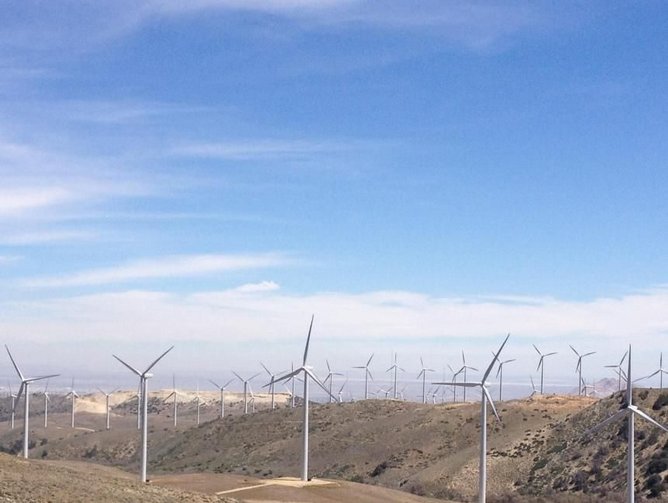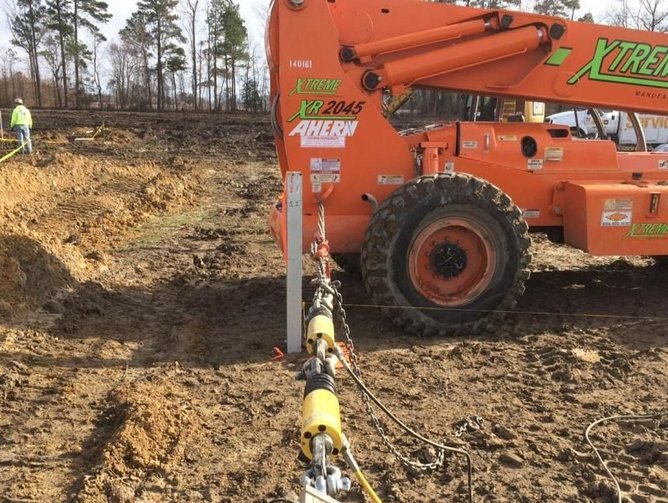Terracon: Bringing foundation to an emerging energy market
Terracon has been delivering consulting engineering services to clients for more than 50 years. The company, based in Olathe, Kansas, provides geotechnical, environmental, and materials testing services across a number of strategic business sectors, including power generation, oil and gas, transportation and facilities.
Over the last two years, the company has experienced significant growth in one particular sector, power generation and transmission, recording a growth rate of 20% year-on-year.
Heading up the company’s Power Generation and Transmission team is Blair Loftis, an experienced project manager having worked in the fields of both construction management, financial optimisation and operational risk management within an electrical utility.
Having that experience in risk management, particularly in the engineering construction industry, proves key to Loftis’s strategic decision making.
“Anybody who wants to get into energy, I recommend that they get to the field first,” he says. “Spend some time in construction, understand first-hand how projects are executed and then you begin to see and feel the issues and problems that come with the construction of infrastructure in the power generation space.”
Loftis feels the power generation market, renewables in particular, is undergoing something of a gold rush, as more and more companies are investing heavily in ways to find more efficient and ultimately cost-effective ways to generate power.
This brings about its own form of pressures, as the demand for finding the solution increases and the timeframes for those solutions grows shorter and shorter.
Terracon’s team encompasses more than 4,000 employees in more than 140 offices, so project management proves key in ensuring that each and every one of those employees are being effectively utilised.
“It’s about ensuring that we can pull the right resources from across our enterprise and use them effectively,” says Loftis.
“Having the right perspective as to understanding where your resources are and how to best utilize them, that’s key. It’s a challenge that affects not only us but the wider engineering space.”
As the company has operated for more than 50 years, delivering consistent success and quality of service, Loftis knows where the company’s strengths lie.
“We’ve really focused on what we are good at. We don’t try and be something we are not, we focus on our strengths and that is in geo-design, and more importantly, finding where we as a business can offer the most efficacy and value for our clients.”
The wind energy generation market is an increasingly growing one. Loftis notes that 50% of the capex within the construction cycle of a wind farm goes into the turbines themselves, with the remaining 50% going into “balance of plant” (BOP) – roadways, conductor systems and other infrastructure elements.
The key for Terracon is finding where it can add value into that construction cycle, and Loftis has located it in the foundations.
At a time where the focus on wind energy generation is growing, the result of this increased demand has been to increase the size of the turbines, the height of the tower, and the length of the blades. In turn, the foundation system grows larger and more expensive.
The market is moving towards larger turbines for land based applications; from a typical size in the 2 MW family to turbines rated at 3 to 3.5 MWs. Traditionally, the turbines have been constructed with a Gravity Spread foundation design, but with the additional mass at the top of the tower from these larger machines the industry was ripe for a paradigm shift. “We needed to introduce a means of reducing the huge quantities of concrete and steel required for the foundation systems associated with the preference for bigger turbines”, says Loftis.
- “50% of the CAPEX is BOP, and 25% of that is in the foundations, so the challenge then became working out what we can do to optimise the foundation design in order to reduce the overall cost of the construction,” he says.
The solution? The Patrick & Henderson (P&H) Tensionless Pier Foundation, a design that requires a third of the amount of concrete and steel and requires 25% the excavation and backfill when constructing these larger wind turbines. According to Loftis a small experienced crew can easily complete five foundations per week under favourable site conditions. Terracon works closely with qualified P&H foundation construction contractors such as Blount Construction and JBS Energy Solutions to make sure that the design aligns with the construction execution process. Other large EPC firms such as Blattner Energy, Inc. also has extensive historical experience with the P&H foundation and just recently completed a project with the P&H foundation solution in Northern California.
“The P&H foundation has a lot of attributes that reduce the risk profile when you compare it to the traditional Gravity Spread foundation. There have been fatigue failures in the spread foundations. Some of these leading to catastrophic failure of the foundation system. The P&H foundation is constantly under compression so there is no fatigue generated by alternating tension and compression that occurs in the gravity spread” says Loftis. “So not only the cost savings, but the reduction of risk has made this design more favourable to wind farm owners and those investing in them.” In addition to this “tensionless pier foundation” Terracon offers to other P&H foundation options, the P&H Rock Anchor foundation and the P&H Soil Anchor foundation. This provides for alternative cost saving foundation options even in rare circumstances when the tensionless pier foundation might not be compatible with site conditions.
Terracon formed an exclusivity agreement with four other companies working as a tight team- Williams Form Engineering Corp., Contech Engineered Solutions, Patrick & Henderson and Structural Observations Services - to be the only provider of the P&H solution in the wind generation market.
It is through this collaborative effort that Terracon establishes itself as a key player in the market, one that stands tall amongst any of its closest competitors.
“It’s an example of the level of innovations that we bring to all our markets, not just wind, and that helps us build client relationships,” says Loftis. “We bring efficiency and economy and locate the value proposition like no other, and through this approach we partner with clients to help them achieve their strategic goals.”
While Terracon can point to the fact that no other company can offer the P&H foundation solution in the wind market, it does have other competitors in the solar space and electrical transmission. But the company has one advantage that no other can compete with, and it comes with experience.
“We have over 50 years of geotechnical data from our work with clients throughout our history,” says Loftis. “That works out at approximately $1bn worth of geotechnical data that we have - no one else has that volume or coverage of data.”
Terracon has been investing $2mn each year in digitizing that data which will consequently provide greater access to it, both internally and externally on the client side. This allows for Terracon, when working with a client, to mine its data at no capital costs. Without sending a single piece of equipment into the field, Terracon can already inform the decision and design process for its clients. But what if the company has to enter the field?
“If we go out into the field, our repository of proprietary data helps us to economize,” says Loftis. “We don’t need to take samples or new data every mile of the way, we can do it every other mile or more. It quite literally cuts the time and cost in half for many projects, allowing the client to better understand the risks and opportunities from the very beginning at a much more effective cost. No one else in the market can offer that value.” This he says is an example of “methods consulting,” rather than just relying upon a wrote set of broad based industry practices.
In the solar market Terracon also excels by determining the minimum required embedment depth for the steel tracker foundations. This is extremely important says Loftis, “Take for example a 100 MW utility-scale solar farm. If we can minimize the required foundation embedment depth by 12 inches that conserves over 15 linear miles of steel. A significant reduction in construction CAPEX.” Terracon’s competitors strive to do the same, but the advantage is the expanse of Terracon’s enterprise. With more than 140 offices local knowledge of soil and geotechnical conditions make Terracon stand apart from the rest. “We have participated in the design of solar projects in 44 states in the U.S., in Canada, Mexico, and LATAM, it is our local expertise that has enabled us to gain this level of market share”, he says.
True to the theme of innovation, Terracon has designed a proprietary system to test and evaluate the load forces of the solar foundations. Terracon’s mobile load testing tripod meets the ASTM standards for testing of deep pile foundations. This, according to Loftis, provides for a higher level of data accuracy and reproducibility, thus allowing for a higher acuity of design optimization. Equally important is Terracon’s partnerships with qualified and experienced foundation installers like Houser Solar Services (HSS). “Using construction grade equipment and experienced partners to install the test piles is essential to producing quality data”, says Loftis.
It would be easy for Loftis to rest on his laurels. After all, Terracon is a market leader and utilizes innovation that others can only follow behind. Instead, Loftis actively seeks out disruption in order to continuously push the boundaries as to what Terracon can offer to its clients.
“As the market heads towards bigger foundation designs and larger turbines, the older, more commonly used foundations become functionally redundant,” he says. “And that’s what we want to do. To make things functionally redundant and ask the question, how can it be done better? How can we improve our efficiency? Let’s change the game completely. That’s what Terracon is all about.”
As part of a five-firm collaborative, Loftis owes a lot of his success in power generation and transmission to the collective efforts of that team. Loftis notes of the sense of brotherhood across the partnership, ensuring that each partner’s interests are accounted for, considered and accommodated.
“We share in the risk and we share in the reward,” says Loftis.
And it’s an approach that extends outward to the client relationships.
“We focus on our client’s biggest challenges, those hurdles keeping them from getting to the next step. Our goal is to assist in maximizing the prudent allocation of project development capital while minimizing capital at risk.” However, Loftis is not completely averse to risk. “Our clients must be willing to take a risk to reach the next level. We will partner with them in managing the risk, but if their risk tolerance is too low, then the prospects for reward are bound to be lacklustre. To practice industry disruption you must be willing to face risk, look forward with optimism, and burn the boats behind you. These are the pillars of progress through innovation.”
Blair is an ultra-athlete. He has run to the top of the highest mountain in the conterminous United States and run solo from the south rim of the Grand Canyon to the north rim and back again…in a single day. With four busy children, youngest with Down Syndrome and a wife who is a nationally acclaimed trial attorney he doesn’t get much sleep. When young scientist and engineers ask to join Blair’s team he asks one two-part question…Are you an athlete or an insomniac? Beating the punch to their response he offers that if you are both then you will be a rock star in the power market.





